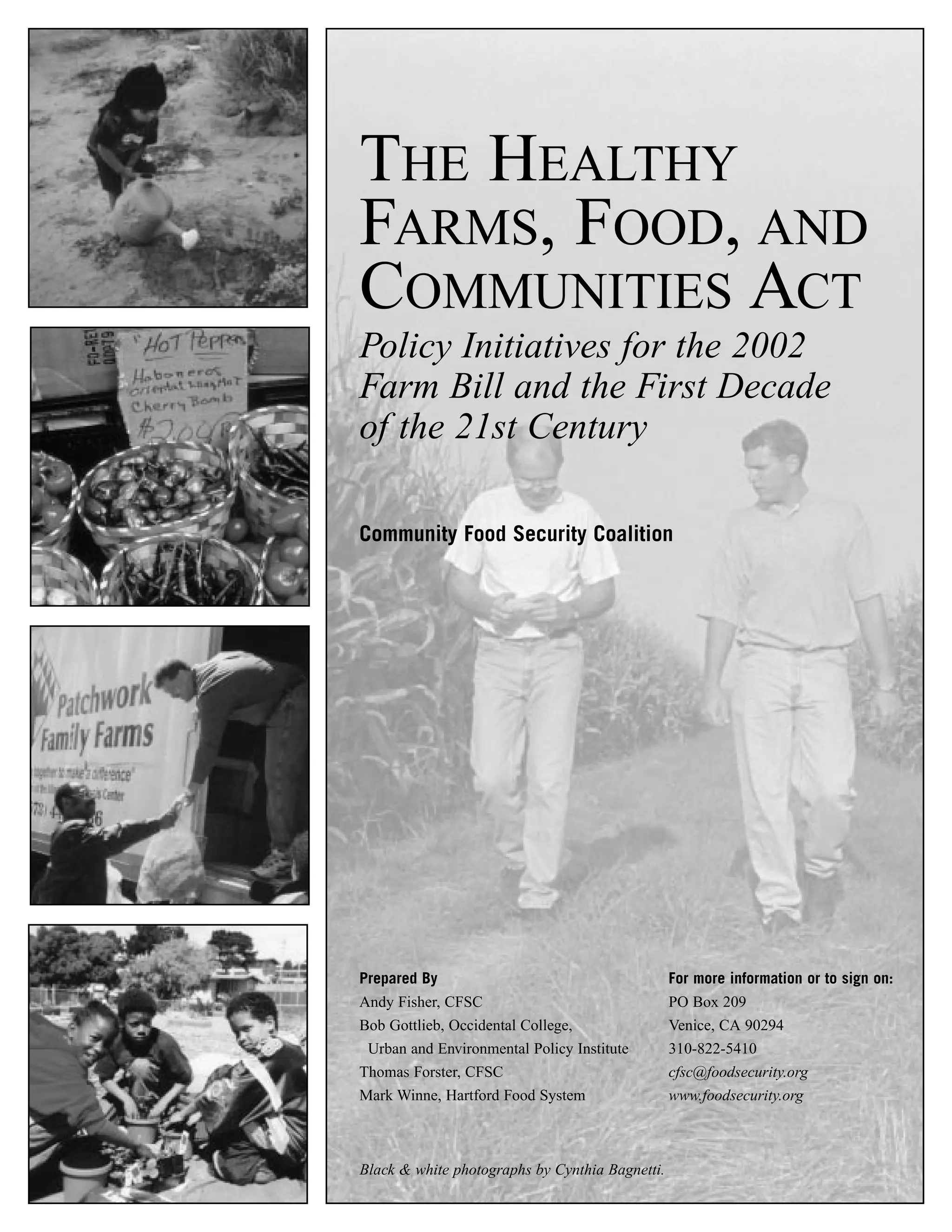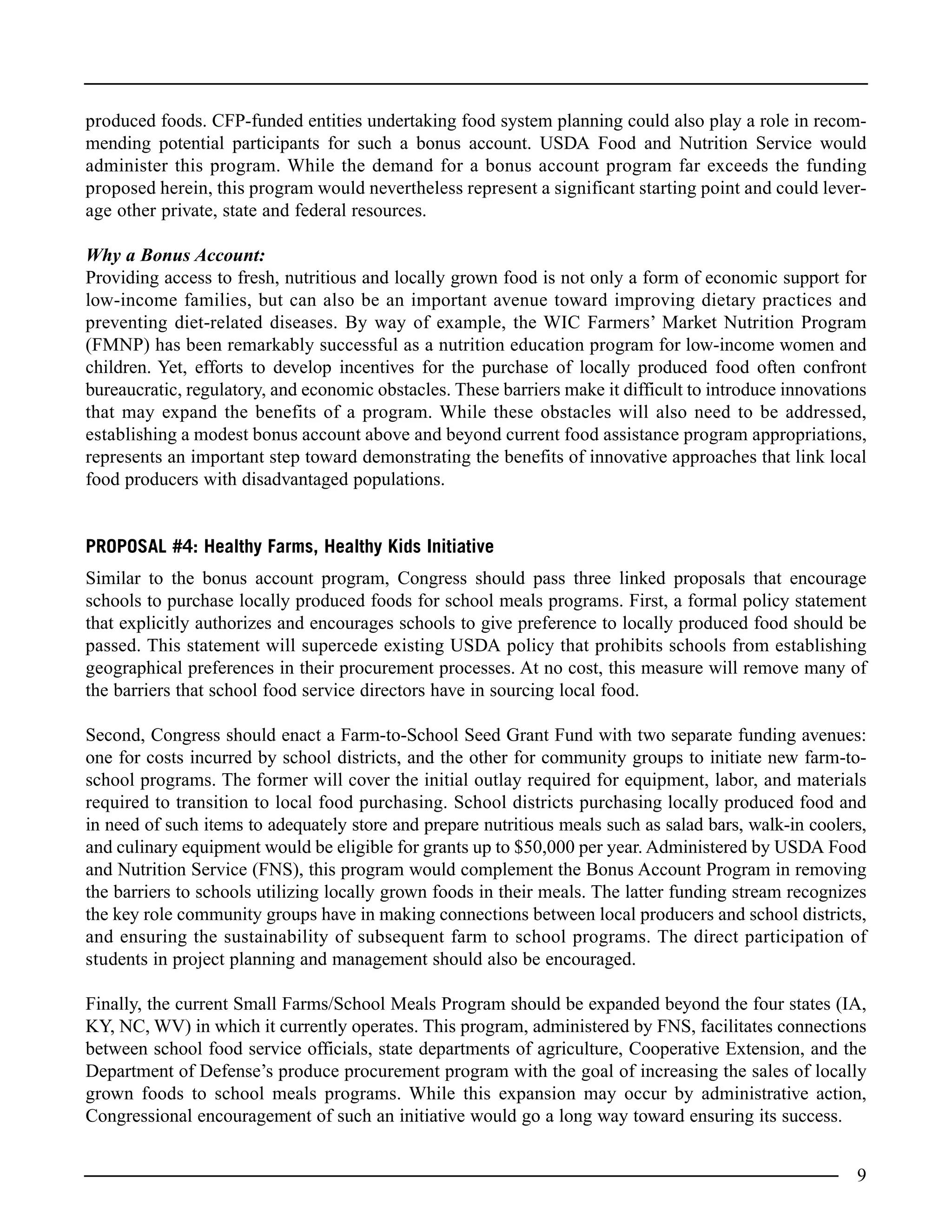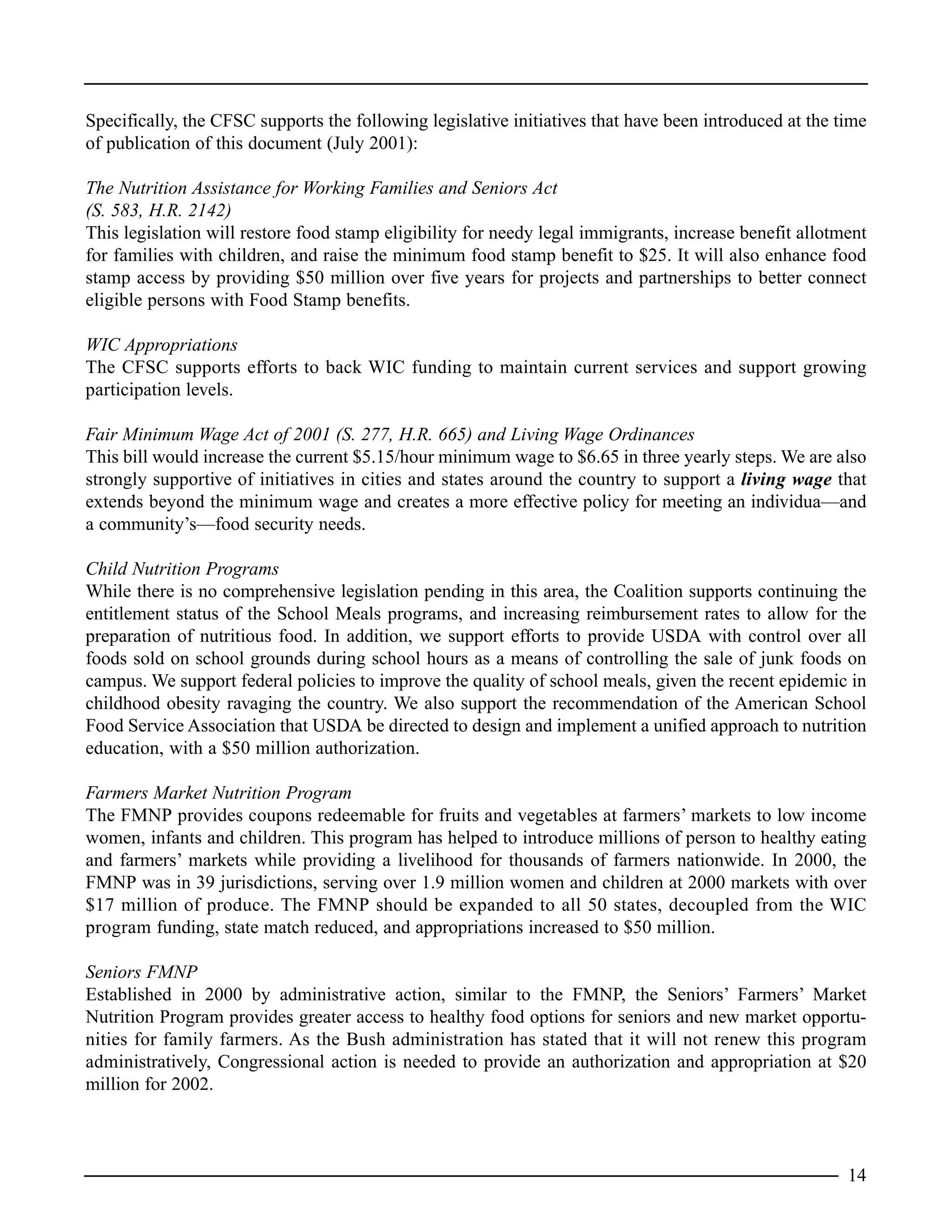This document proposes the Healthy Farms, Food and Communities Act (HFFCA) as a legislative initiative for the 2002 Farm Bill. The HFFCA includes five key proposals that expand existing programs like Community Food Projects to strengthen local food systems and improve access to healthy food. These proposals aim to support family farms, address food insecurity, and promote community food security through programs totaling $70 million annually.


![EXECUTIVE SUMMARY
The Healthy Farms, Food and Communities Act (HFFCA) renews and expands the policies and
approaches first outlined in the Community Food Security Coalition’s 1995 Community Food Security
Empowerment Act document. The HFFCA includes a legislative initiative to be incorporated into the 2002
Farm Bill, and a broader set of policy principles and legislation that we endorse. Both of these policy
platforms—the Farm Bill initiative and an overarching policy approach create the basis for furthering the
goals of healthy farms, healthy food, and, ultimately, healthy communities.
Farm Bill Summary
As part of the 2002 Farm Bill, we propose a five–part legislative initiative that expands on the
Community Food Projects (CFP) program. Since the program’s inception, CFP grants have helped
generate a number of creative and successful projects that have enabled communities to reduce hunger,
improve residents’ nutrition, and support family farmers. The proposals contained in this initiative
represent a budget request of $70 million per year, a modest and reasonable investment considering the
enormous pressures for alternative strategies and creativity in adapting the present food system to meet
the needs of vulnerable populations such as low-income residents and struggling family farmers. The
provisions include:
1] Reauthorizing and increasing mandatory annual funding to $7.5 million for the core Community
Food Projects Program and provide an additional $2.5 million for a new mini-grants component for
smaller single focus projects such as community kitchens or garden projects ($10 million).
2] Incorporating a Planning Grant component to the Community Food Projects Program to fund program
and business planning and community food assessments to guide successful project development ($5
million).
3] Establishing a Local Food Bonus Account to increase the purchase of locally or regionally produced
food by institutions serving low and moderate-income households ($25 million).
4] Launching a USDA Healthy Farms, Healthy Kids Initiative to integrate a general policy to purchase
locally with a Farm-to-School Seed Grant Fund and expansion of the current Small Farms/School
Meals Program ($15 million).
5] Creating a Community Food Security Research, Training, and Education program to link and
develop research programs to support community food security assessments, new model strategies
and a new generation of scholars in this field ($5million).
The Community Food Security Coalition’s “Healthy Farms, Food, and Communities” legislative package
for the 2002 Farm Bill provides one important route for beginning to develop a healthy food system. The
task of restructuring the nation’s food and farm policies is massive, and one requiring broad and deep
2](https://image.slidesharecdn.com/cfscreport-101126012551-phpapp02/75/The-Healthy-Farms-Food-and-Communities-Act-2002-3-2048.jpg)








![PART II:
Creating a Just, Democratic, and Sustainable Food System:
Linking with Other Legislative and Policy Initiatives
Building Coalitions and Broader Movements for Food System Changes
The Community Food Security Coalition’s “Healthy Farms, Food, and Communities” legislative package
for the 2002 Farm Bill provides one important route for beginning to develop a healthy food system. The
task of restructuring the nation’s food and farm policies is massive, requiring broad and deep changes in
a number of sectors. The CFSC, with its food system focus, is supportive of many of these efforts, as we
see ourselves as part of a larger set of organizations and movements seeking to transform what has
become an unjust, undemocratic, and unsustainable food system. Collectively, these groups and cam-
paigns, particularly those that have a sustainable agriculture, anti-hunger and nutrition, food access, and
sustainability focus can constitute the basis for a coordinated and strategic approach to redirecting the
Farm Bill (as well as other legislative and policy initiatives) and create the basis for food system change.
What follows below are basic policy goals and principles as well as specific policy initiatives that the
CFSC supports. Many of these are attached to the 2002 Farm Bill, while others extend beyond this
crucial piece of legislation. We see this document as a living document for food policy change, subject to
updates, additions, and changes as the political and social context evolves.
Farm Policy Initiatives
It is now a decades old truism that the family farm – and beyond that farming as a way of life– is in serious
trouble. It is well established that domestic farm policies, including those embedded in previous Farm
Bills, have become heavily weighted towards exports and agri-business, contributing to the demise of
family farmers. Global trade has hurt many farm sectors; Freedom-to-Farm (the euphemistic title of the
1996 Farm Bill), in eliminating price supports, pulled the rug out from under many commodity crop
farmers; emergency (AMTA) payments have proven to be a subsidy for agri-business; USDA has stood
idly by while a few companies hold monopoly powers over key sectors; and mergers and buy-outs
continue at a phenomenal rate, creating centralized, consolidated, and globally-oriented sectors of the
food system in a matter of years rather than decades.
Ultimately, food and farm policies can help undo what they have also wrought. Along those lines, the
Community Food Security Coalition supports policies that:
1] Provide independent family farmers with a larger share of the food dollar; enable farmers to earn a
fair price-one that covers their costs of production and a return on investment—from the marketplace;
and open new domestic markets;
2] Encourage on-farm conservation practices and reduced agri-chemical usage;
3] Increase competition among and reduce the monopoly power of agri-businesses;
11](https://image.slidesharecdn.com/cfscreport-101126012551-phpapp02/75/The-Healthy-Farms-Food-and-Communities-Act-2002-12-2048.jpg)
![4] Provide support to minority and family farmers to gain fair access to government services and
programs;
5] Preserve farmland from development and reduce sprawl;
6] Support the ability of farmworkers to earn a fair wage, and safe and dignified working and living
conditions.
Specifically, the CFSC supports the following legislative packages that have been initiated at the time of
publication of this document (July 2001):
Food from Family Farms Initiative
Advocated by the National Family Farm Coalition, this proposal addresses the economic crisis affecting
America’s family farmers by ensuring that farmers are paid a fair price from the companies and
processors who buy their commodities, not from taxpayers. This farm program limits economically and
environmentally damaging overproduction through a supply management program.
Agricultural Communities Revitalization and Enterprise Initiative
Since concentration and vertical integration among processors have increased to such an extent that farmers
and ranchers have very few market access options, a key component to the development of a more
sustainable food and agriculture system is the empowerment of farmers and ranchers to retain control of
their product longer, improve their access to consumers, and increase their share of food system profit.
Towards that end, the Agricultural Community Revitalization and Enterprise (ACRE) Initiative would
create a $500 million per year federal program to provide competitive grants to support research,
education, market development, and farm innovation that increases the farm and ranch share of food
system profit; and supports entrepreneurship, value-adding enterprises, new production systems, and
alternative marketing channels.
Conservation Security Act
The Conservation Security Act (CSA) of 2001 promotes farmland in active production practices that
improve environmental quality. Farmers would get support for their long-term commitment to sustainable
production methods. As such, the Conservation Security Act would be an important complement to set
aside programs by addressing farming-related environmental problems at their source: the way crops and
livestock are actually produced.
Competition Title
Many of the nation’s agricultural sectors are characterized by a few giant purchasers of raw com-
modities, and a few giant providers of inputs (seeds, fertilizers, pesticides, etc.). This concentration has
serious impacts on the economic viability of the independent family farmer, and consequently on the
sustainability of rural communities. While there is no comprehensive legislation currently proposed to
address the lack of competition in much of agriculture, the key elements of a Competition Title in the
2002 Farm Bill have been identified in a sign-on letter organized by the National Campaign for
Sustainable Agriculture, and endorsed by 60 organizations, including the CFSC. A collaborative effort
organized by the National Campaign to draft a Competition Title has thus far identified improvement
in, and better enforcement of, the Packers and Stockyards Act, and provisions to ensure fair contract
bargaining rights for farmers and ranchers, as priority concerns. Contract agriculture is growing rapidly
in virtually all sectors of agriculture and is an issue about which consumers and producers should be
much more aware.
12](https://image.slidesharecdn.com/cfscreport-101126012551-phpapp02/75/The-Healthy-Farms-Food-and-Communities-Act-2002-13-2048.jpg)


![Transportation and Access
A core concern for community food security is access to affordable, nutritious and fresh food. Within the
world of transportation planning, the focus on food access has been, at best, a stepchild to the larger
emphasis on commuting and highways. Where available, food access-related transit services are ad hoc
in nature, largely uncoordinated. There exists a lack of policies - and a lack of federal dollars—to enhance
a community’s ability to access healthy food from various retail outlets. This is true despite the fact that
food shopping constitutes the second most significant transportation need, outside of commuting to work.
In the Transportation Enhancement Act for the 21st Century (TEA-21), transportation policy’s equivalent
of the Farm Bill, a funding stream was created to provide transportation assistance for ex-welfare
recipients commuting to their new jobs. Efforts to modify this bill to include food access related purposes
in the funding criteria were unsuccessful and thus a food access transportation approach was never
implemented through this legislative venue.
Even as it failed to address poor food access in inner city communities, federal transportation policy
has itself become a factor in extending such lack of access. Massive expenditures in infrastructure such as
the interstate highway system facilitated sprawl and the migration of the middle class to the suburbs.
Supermarkets soon followed- and even influenced these prevailing migration patterns, abandoning urban
centers and compounding the lack of access to fresh and less expensive food and other needed services.
Further destroying the basis for local food systems, highway-facilitated sprawl has been a prime cause of
farmland loss in the nation’s metropolitan areas.
1] The CFSC supports revamped transportation and smart growth policies to create a more sustainable
and socially just food system, including those that:
2] Reprioritize domestic transportation goals to foster redevelopment of inner city communities in lieu
of expanding new developments on existing farmland;
3] Improve access to healthy and affordable foods for the transit dependent in rural, suburban and urban
communities.
While there are no current legislative proposals on these topics, the reauthorization of TEA-21 in 2003
will provide an important opportunity to address these issues. The CFSC will be working with other
sustainable transportation and social justice coalitions to ultimately establish a food access funding
stream and policy orientation through this legislation.
TAKING BACK THE FOOD SYSTEM: A CONCLUSION
Federal policy changes, including those associated with the upcoming 2002 Farm Bill, can play a critical
role in reversing decades of concentration in the food system, protracted community food insecurity,
including lack of access to fresh and nutritious food, decline of family farms and rural communities, and
environmental degradation.
To take back the food system for communities, farmers, and consumers, and create a more just,
democratic, and sustainable food policy requires action at all levels—from Congress to neighborhoods.
Change begins to happen when people are able to act in concert and build the kinds of partnerships that
make change possible.
For the food system, the process for making change has begun. Join us!
15](https://image.slidesharecdn.com/cfscreport-101126012551-phpapp02/75/The-Healthy-Farms-Food-and-Communities-Act-2002-16-2048.jpg)
